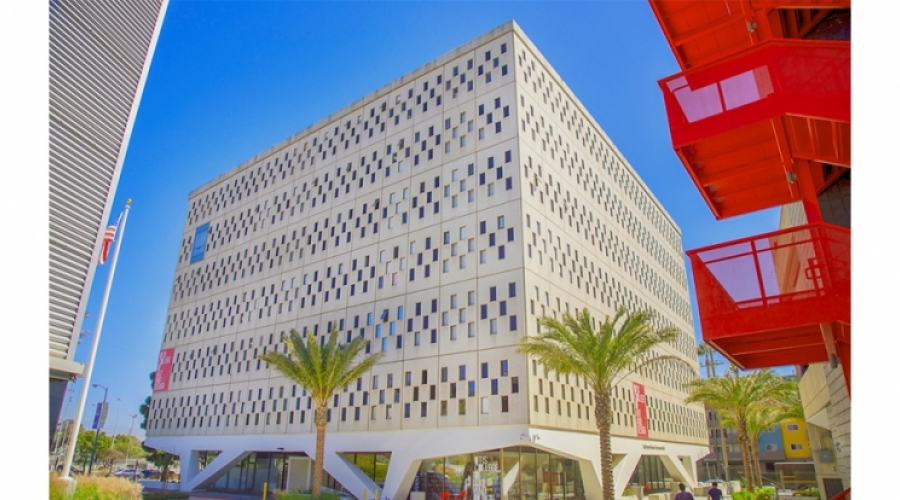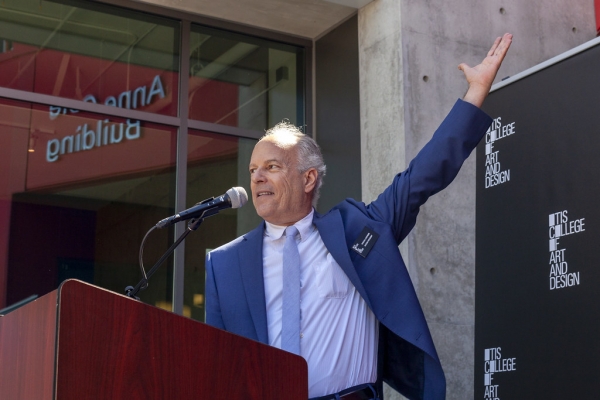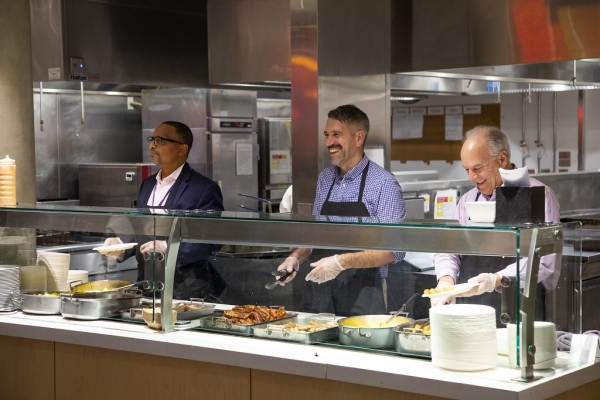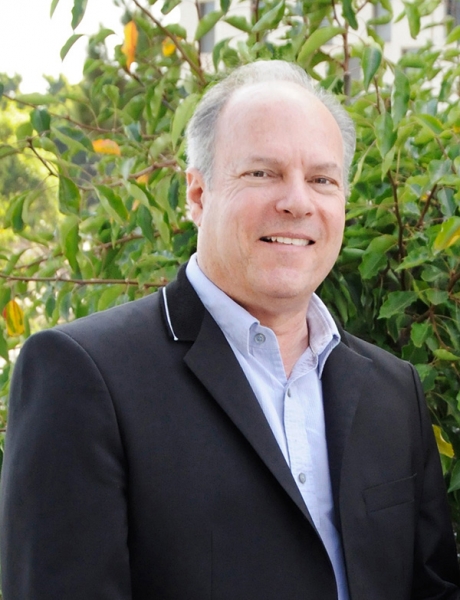
Dear Extended Otis College Community,
I write to share some reflections on a life and career that I’ve spent at Otis College of Art and Design—most recently as Interim President—including some thoughts about moments of sudden change, reminiscent of what we’re experiencing today.
 Having begun teaching part-time in the early 1980s for the first-year Foundation Program at what was then called Otis Art Institute of Parsons School of Design, or Otis/Parsons, I recall meeting and collaborating with faculty colleagues, discussing issues of shared governance with them, as well as with staff and senior leaders, and contributing to the development of what has become a signature multi-disciplinary first-year experience—Foundation—that oriented new students to our art and design disciplines through focused study of aesthetic and media-handling fundamentals. In those years, the College was under the auspices of the New School for Social Research, which “owned” Parsons and next acquired Otis. As a subsidiary sister school of another long-standing institution on the East coast, many at Otis found life under our “parent” notably constraining—much like a teenager might view their life under their parents’ roof. At a stage, it even became necessary to strike back out on our own.
Having begun teaching part-time in the early 1980s for the first-year Foundation Program at what was then called Otis Art Institute of Parsons School of Design, or Otis/Parsons, I recall meeting and collaborating with faculty colleagues, discussing issues of shared governance with them, as well as with staff and senior leaders, and contributing to the development of what has become a signature multi-disciplinary first-year experience—Foundation—that oriented new students to our art and design disciplines through focused study of aesthetic and media-handling fundamentals. In those years, the College was under the auspices of the New School for Social Research, which “owned” Parsons and next acquired Otis. As a subsidiary sister school of another long-standing institution on the East coast, many at Otis found life under our “parent” notably constraining—much like a teenager might view their life under their parents’ roof. At a stage, it even became necessary to strike back out on our own.
Trustees Elaine Goldsmith and Bronya Galef formed at that time a new support body for Otis, which informed the New School of their intention to separate, and Otis College of Art and Design was incorporated as an independent, non-profit entity. The Board—just a few individuals then—hired Neil Hoffman as President, Chris Alford as Vice President of Finance and CFO, and Mark Salmon as Vice President of Academic Affairs. Now out of its parents’ house, so-to-speak, and with new management and the generous support of a small Board of Trustees, Otis not only stood on its own two feet, but it quickly walked, ran, grew, and settled into new quarters here on the Westside of Los Angeles, on land purchased for what today amounts to less than the average price of a four-bedroom home in many parts of Los Angeles.
Upon Hoffman’s retirement, Otis secured a young new president who came from a museum school in Washington, D.C. Samuel Hoi (affectionately known as “Sammy”) set about developing Otis College’s first formal strategic plan with all campus constituents. Under that plan, and with Sammy’s leadership, we applied for and secured substantial grants, cultivated donor interest, grew the Board, launched several new majors (Digital Media, Product Design, and Toy Design), and earned highly favorable WASC and NASAD accreditation status.
During these years of growth and relative prosperity, however, the U.S. experienced two historic economic recessions. In the year 2000, soon after breathing a collective sigh of relief with much of the world at finding our computers and financial systems intact at the turn of the new millenium, the dot-com bubble burst, leaving many of our students, and the families who supported them, with severe personal and business-related financial losses. Not long after the dot-com recession, the Great Recession of 2007-2009 came with the collapse of the U.S. housing bubble, leading to a global and longer (by three times) financial crisis.
Both harsh recessions posed threats to Otis. As is true of any independent college, student-paid tuition is the main source of revenue that supports operations. In an “expense/revenue” business model like ours, we collect only as much tuition revenue as it actually costs to provide the quality education we offer—hence our non-profit status. Since Otis logically depends on students seeking, financing, and completing their degrees with us in order to provide our programs, we experienced some enrollment decline during past recessions.
However, due to its competitiveness in the world market for higher education in art and design, and to the fact that specialized education sometimes experiences less enrollment decline in recessions than do general college settings, we adjusted to our variable enrollment and continued to thrive—if a bit smaller—until the next cycle of enrollment growth, the next Provost or President change, or whatever other challenge to our success came next.
 Today, as I conclude my 14-month Interim Presidency, help Otis welcome Charles Hirschhorn as its new President, and prepare to continue helping him and the College in a consultative role going forward, we find ourselves managing yet another sudden, disruptive change—this time a global health pandemic, of all things. This whammy not only closed our campus and housing facilities over two months ago, it set in motion an adaptation and reimagining fervor that would impress any force for any cause, anywhere. As we plan now for Fall 2020, I am reminded of challenges past, and how the heart of Otis led us through.
Today, as I conclude my 14-month Interim Presidency, help Otis welcome Charles Hirschhorn as its new President, and prepare to continue helping him and the College in a consultative role going forward, we find ourselves managing yet another sudden, disruptive change—this time a global health pandemic, of all things. This whammy not only closed our campus and housing facilities over two months ago, it set in motion an adaptation and reimagining fervor that would impress any force for any cause, anywhere. As we plan now for Fall 2020, I am reminded of challenges past, and how the heart of Otis led us through.
Each of the unforeseen change-inducing events in our distinguished history pushed the talent, brain power, will, and fortitude of our students, faculty, and staff, and, with those pushes, Otis triumphed, regained its strength, and rose to successive new heights. The heart of Otis is forged of the truly creative thinking, aptness to pitch in, get-it-done attitude, goodwill, and shared commitment of all who work and study here—those who make Otis go, and who bring to it their remarkable grit, persistence, and unwavering motivation to succeed.
I am most pleased to have had the opportunity to work closely during my Interim Presidency with many people who fit just that description, and who are today carrying Otis forward through brilliant research, planning, and innovation toward the next era. Otis’s Board Chair, Mei-Lee Ney, our Trustees, and each member of the College’s Senior Team are all leading us in this time of unique challenge. And Charles has spent two months with us already learning about Otis, the work we do, and our campus culture, while proactively helping us through the Otis Is Essential fundraising campaign and other means to take care of our students, faculty, and staff as we navigate new conditions and constraints.
I can’t help noting how, once again, the heart of Otis continues to push us through delays, inconveniences, and disruptions, fueled still by the impressive efforts of so many within our resilient community—from the students and our innovative, agile faculty, Chairs, and Directors, to the countless staff members working expertly to keep our systems running and our plans progressing toward a return to our studios, classrooms, shops, and labs this Fall.
 With firsthand, long term knowledge of Otis’ great strength and tenacity, I look forward to continued success and new heights for this small but mighty college.
With firsthand, long term knowledge of Otis’ great strength and tenacity, I look forward to continued success and new heights for this small but mighty college.
I know that the leadership and all who work here will take good care of our students and each other through this moment of transition, challenge, and renewal. The heart of Otis, combined with the tremendous, life-propelling programs and experiences it provides for students, will prevail and carry on to the other side, long after the pandemic, to a truly great new era.
With deep respect and gratitude for all involved with Otis College,
Randall Lavender
Professor, former Provost, and former Interim President


